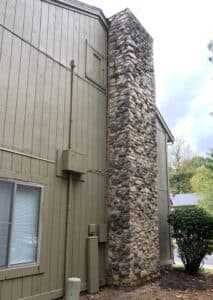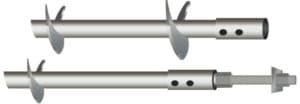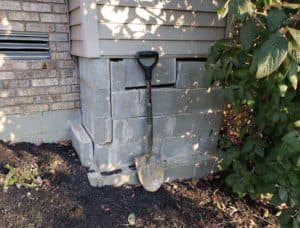
Originally posted 5/1/19, updated 9/3/21
A fireplace is usually the focal point in your living room. It may also be a source of heat, if you actually light a fire within it (or turn it on, if it’s been converted to a gas “log”). It can also be a warning sign of potential foundation problems, if it begins to pull away or lean into the home.
Acculevel is a family-owned and operated company that specializes in waterproofing and foundation repair. The same repair methods we use on a settling house foundation -helical piers- are incredibly effective when used to fix a leaning chimney. Since our start in 1996, we’ve helped more than 30,000 homeowners in our service area restore their homes to health and stability.
In this article, we’re going to review what causes a chimney to lean, signs that the damage has spread to your home, and the best repair methods for fixing both chimney and home foundations.
Most home builders do not construct chimneys; they contract with a bricklayer to do that. This is because chimneys are made of brick (or stone) and mortar, and masonry is a specialized skill.
When your home was built, the construction company excavated and set up the footings (concrete bases that stabilize the foundation). They then poured the floor, built your home’s foundation, and poured a small concrete slab next to that for the mason to use.
What this means for you is: when your chimney begins to pull away from or lean into your home, it’s usually a sign of the foundation settling. But whether this settling has affected just the chimney or both the chimney and foundation settling is not immediately clear. You’ll need to look for signs of settling in the house, to determine that (we review those later in this article).

This photo was taken by an Acculevel project advisor during a free estimate appointment. The chimney is beginning to lean away from the home- the gap is widest at the top.
Foundations settle when the ground beneath them moves. Some settling is absolutely normal- as the weight of your home pushes down on the earth, it sinks in tiny increments. What causes problems is when the foundation settles at an uneven pace. This isn’t unusual in homes with chimneys, because the weight of a chimney is substantial and all of that weight is concentrated on a small piece of concrete.
If the soil wasn’t properly compacted before the foundation was placed, this can speed up the settling process. Water is another factor, because it can erode the ground below the foundation.
Heavy rains or flooding can also create issues; when soil absorbs water, the dirt expands and pushes against the chimney foundation. A third option is if the footing (the base under the slab) is not sized appropriately for the weight of the chimney.
The signs of a settling chimney may start small, but they’ll become noticeable quickly. Gaps or cracks will form in the wall next to the chimney. You may feel a draft or hear a faint whistling on windy days. You could also experience some water intrusion during major rainstorms.
Your home’s foundation can also be affected by the same factors that cause your chimney to settle, but the symptoms are somewhat different. The three major signs of a foundation settling are:
Helical piers are long steel posts with curved ‘blades’ to help them grip into the earth.

This is an illustration of a helical pier.
The piers are ‘screwed’ into the earth until they reach stable, undisturbed soil (measured by pressure gauge). Once the necessary pressure is reached, they are then attached to your foundation by bracket. Piers, when properly installed, should prevent the foundation from shifting any farther into the ground.
In some circumstances, piers can also lift the foundation. This should be discussed with the project advisor or contractor you meet with, to determine if this is a desirable outcome. When you’re trying to raise a home’s foundation, there’s a chance of cosmetic damage occurring.
 This photo was taken by an Acculevel team member before piers were installed. You can see there are gaps forming between the blocks in the chimney.
This photo was taken by an Acculevel team member before piers were installed. You can see there are gaps forming between the blocks in the chimney.
 Piers have been installed, and the brackets have been attached. The gaps have closed, as the chimney base is lifted. You can see the far corner of the home’s foundation also needed to be repaired; a second pier was installed to the left of the chimney.
Piers have been installed, and the brackets have been attached. The gaps have closed, as the chimney base is lifted. You can see the far corner of the home’s foundation also needed to be repaired; a second pier was installed to the left of the chimney.
You should always research a contractor before signing any type of agreement with them. But this is especially important when you are having piers installed. If the contractor is not well-trained in diagnosis and the work crews are inexperienced in installing piers, you may not get the results you’re paying for.
Piers placed in the wrong location, or piers not installed to the proper depth, will not accomplish the necessary repairs. We strongly urge you to thoroughly vet your contractor and their credentials; if the contractor doesn’t use a rotating laser to help them determine pier placement, get a second opinion.
We have developed a guide to questions you should ask a contractor; this free resource comes with a downloadable copy of the questions you can use for any home repairs.
You can learn all about foundation problems, solutions, costs, and repair methods in our comprehensive homeowners’ guide to foundation repair. This free resource is meant to be used any time you have questions about your home or symptoms you may observe. Bookmark it, read the portion(s) that matter to you now, and come back to it the next time you have concerns.
If you have passed “concern” level and are approaching actual worry (or worse, panic!), then contact Acculevel for a free in-home estimate with one of our project advisors. They will sit down with you and discuss what you’ve experienced in your home, what your concerns are, and how best to address them. Once they’ve performed a full assessment of your house, they’ll provide you with a detailed plan for a whole-home solution.
Live outside of Indiana? Out of our service area? Ask friends or neighbors who have needed similar repairs for their recommendations. Check with your HOA or local realtor, for a list of contractors these organizations routinely work with. And always, always make sure they are insured and accredited by the Better Business Bureau.
[DISPLAY_ULTIMATE_SOCIAL_ICONS]